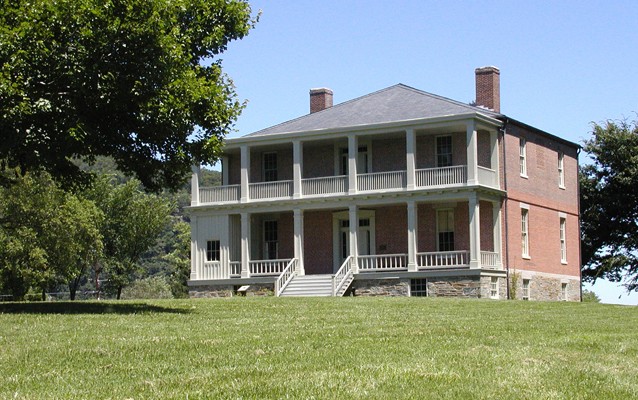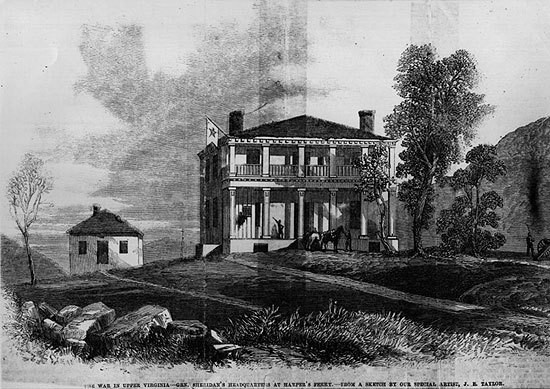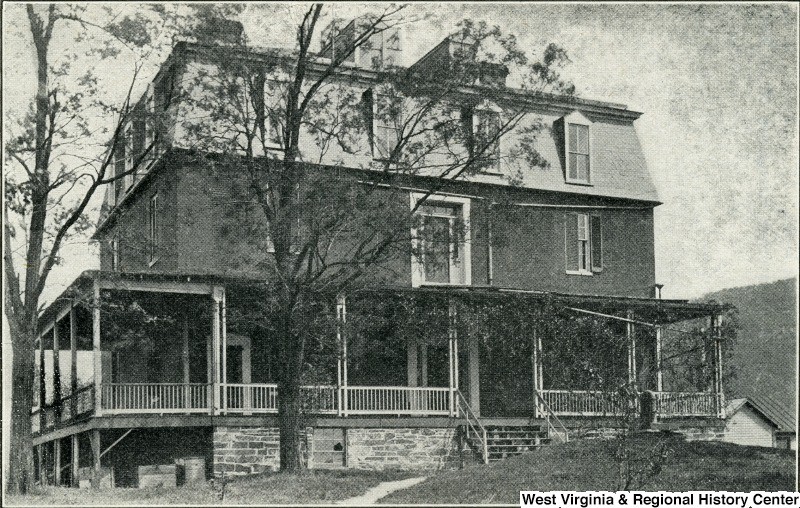Lockwood House
Introduction
Text-to-speech Audio
The historic Lockwood House, also known as the Paymaster’s Quarters, is one of the largest residences in Harpers Ferry. Constructed in 1848, the structure was originally used as the home for the U.S. Armory’s paymaster. During the Civil War the building was used several times as an army hospital and temporary headquarters for both Maj. Gen. Philip H. Sheridan and Brig. Gen. Henry Lockwood. Following the war, the Lockwood House was used by Freewill Baptist missionaries as a school for freed slaves until it became Storer College. Lockwood House fell into disrepair when Storer began moving operations to new facilities at their campus on Camp Hill. In 1960, the National Park Service acquired Lockwood and restored the structure.
Images
Lockwood House today with its restored exterior. Image obtained from the National Park Service.

Depiction of Lockwood during the Civil War. Image obtained from culturalresource.info.

Lockwood House in 1958 with its third floor. Image obtained from the Storer College Digital Collection.

Backstory and Context
Text-to-speech Audio
During the first half of the nineteenth century, the U.S. government owned most of the property in Harpers Ferry including the armory, arsenal, and the employees for these locations. Around 1819, a home was built on the site of the Lockwood House for the new armory superintendent, Captain John H. Hall, who occupied the home until his departure in 1840. From 1840 to 1847, the residence was used by A. M. Kitzmiller, the superintendent’s clerk. In 1847, the home was demolished and a new one was built on the spot to serve as a residence for the armory’s paymaster. The house was occupied by paymaster Col. Edward Lucas Jr. from 1848 to 1858 and by paymaster Dr. Dennis Murphy from 1858 to the start of the Civil War. In 1858, a second story was added.
Lockwood House was frequently used and damaged by military forces during the Civil War. The structure served as a hospital for sick and wounded Union troops in the summer of 1862, including the Battle of Harpers Ferry in September. From July to October of 1863, it was used as the headquarters of Brigadier General Henry H. Lockwood, whom the house is named after. In August 1864, Major General Philip H. Sheridan also used the house as his headquarters during his Shenandoah Valley Campaign. At other times the Lockwood house would be used as a prison and even a ballroom. Heavy use by Union troops, as well as occasional shelling by Confederate artillery, left the house with significant damage.
After the Civil War, Nathan C. Brackett of the Freewill Baptist Home Mission Board arrived in Harpers Ferry and began organizing schools for freed slaves in the local area. One of these schools was in the Lockwood House; the House also simultaneously served as Brackett’s headquarters, his residence, and the residence of several teachers and Black families. In 1867, Storer College was established, with the government transferring ownership of Lockwood House and several other old armory buildings to them for use as a campus. Lockwood served as the college’s first classrooms and dormitories until they transferred to other buildings.
Starting in the 1870s, Storer used Lockwood as both a summer boarding house and hotel. In 1883, a third floor was added. Around 1926, the hotel was closed and Lockwood was rented out by several people during the years following. By the time Storer College closed in 1955, Lockwood House was in a very dilapidated state. Ownership was transferred to the National Park Service in 1960. The exterior of Lockwood House was restored to its Civil War appearance, including the removal of the third floor, and two rooms were restored to their Storer College appearance. Current conservation efforts have been focusing on Civil War graffiti found on some of the interior walls.
Sources
Gilbert, David T. A Walker's Guide to Harpers Ferry, West Virginia. 8th ed. Harpers Ferry, WV: Harpers Ferry Historical Association, 2016.
National Park Service. Historic American Buildings Survey: The Paymaster's Quarters.
National Park Service. Research Report: History of Paymaster’s Quarters, Camp Hill, (“Lockwood” House, Storer College) Harpers Ferry, 1848-1867. By Philip R. Smith. 1959.
National Park Service. Office of Archaeology and Historic Preservation. The Lockwood House: Birthplace of Storer College: Furnishings Study Historical Data Section. By Anna Coxe Toogood. 1969.
https://www.nps.gov/nri/resources/customcf/place/LockwoodHouse.jpg
https://i2.wp.com/culturalresource.info/wp-content/uploads/2015/01/18.jpg? fit=550%2C389
https://storercollege.lib.wvu.edu/imageviewer/wvulibraries:1572/digitalImage
